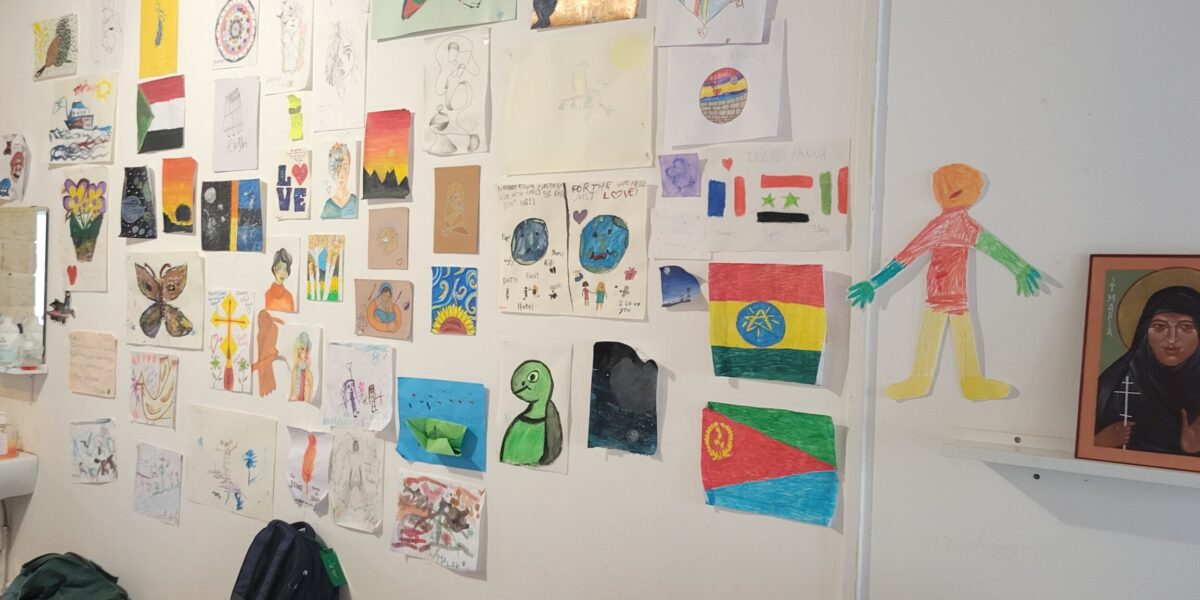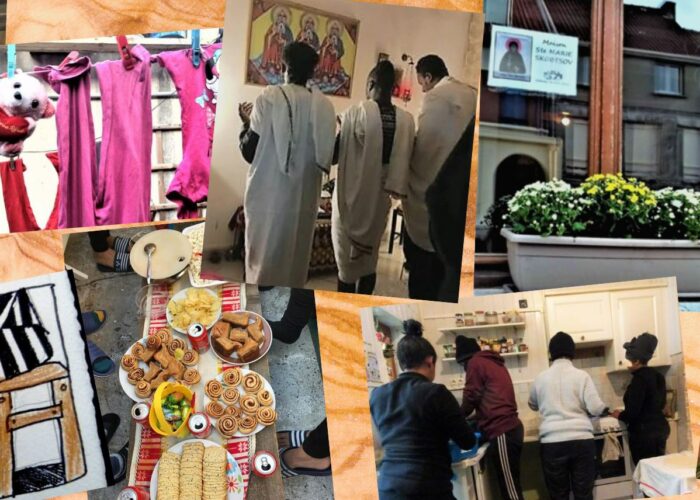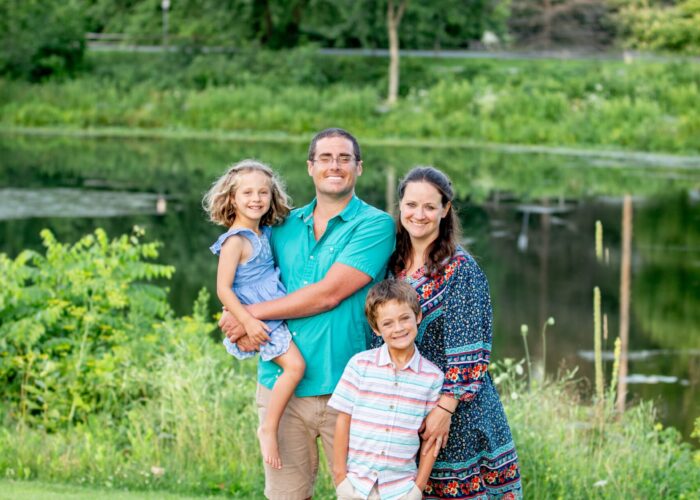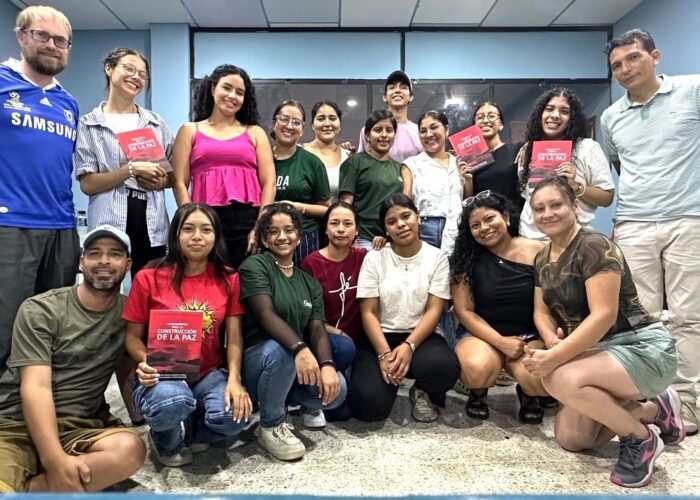Copyright © 2024 by the Christian Century. An architecture of care in Calais by Amy Frykholm is excerpted by permission from the January, 2024, issue of the Christian Century. To read the full article, click here
https://www.christiancentury.org/features/architecture-care-calais.
The Maria Skobtsova House is owned and operated by Mission Network partner
Association Maria Skobtsova (Maria Skobtsova Association).
“Rachel and Joseph” mentioned in the full article are Joseph and Rachel Givens of Mission Network.
Never underestimate the power of the house,” reads a small sign hanging on the wall of the Maria Skobtsova House in Calais, a port city in northern France.
The house in question is a row house in a middle-class neighborhood with partially trimmed hedges and rose bushes. The only thing that sets this house apart from every other house on the block is a simple sign taped to the window that says, “Maria Skobtsova Refugee House.”
On the day in June when I arrived, the front windows were wide open to catch a breeze. Ieva, a young Latvian woman and frequent volunteer, opened the door for me. We’d arranged to meet at 9:30 and maybe have prayer.
Maybe is a key word at the Maria Skobtsova House. Maybe we will have prayer. Maybe this is a day when no new refugees will come. Maybe several new families will arrive. Maybe everyone came in very late last night and will be sleeping this morning. Maybe the weather is good, and tonight refugees will try to reach the United Kingdom by crossing the English Channel in small boats. Maybe the weather is bad, and today is just a day for waiting. Maybe, as on this particular day, little Maryam will already be awake and toddling around, and prayer won’t be quite as attractive as following her and trying to entice her to the table to eat something. (Names have been changed to protect those still in the process of seeking asylum.)
Maryam’s mother, Layla, was at the stove in the tiny kitchen making Iranian-style scrambled eggs in tomato sauce. Ieva put on a pot of coffee. Asma, a Syrian woman also staying in the house, said no to eggs because she was fasting on the eve of Eid al-Adha. We used Google Translate to look up the word that Asma wanted to say about her intentions: “Forgiveness.”
The motion of the house can go from frantic to still, as if it were a little boat on the ocean subject to winds that no one can see or control. Ordinary moments are interspersed with moments of intensity. Full stop; frantic motion. The only thing that volunteers are attempting to do is hold the space so that refugees, who are caught in political and social winds, might have a place to be restored. One of the things that providing hospitality means is taking on a refugee’s own rhythm. Some days, Ieva says, are spent just sitting at the wide, wooden table and having coffee, welcoming one person after another, whoever they are, whatever they need. How you welcome one person, Ieva says, is how you welcome every person.
Other days are spent in trauma. In January, an Eritrean woman was separated from her children on the beach. It was dark, the smugglers saw the police coming, and they launched the boat with her children in it but not her. Years earlier, this woman had lost her son when crossing the Sahara desert and had spent seven years searching for him, through every government and international agency, until they were finally reunited. Now this. He and his half-siblings were crossing the Channel without her. She had an emotional and psychological breakdown on the beach. After some time in the hospital, she came to the house to recuperate and figure out what to do next. It is not uncommon for people to arrive at the house wet, injured, exhausted, dirty, and hopeless.
The house’s origins lie in an impromptu camp in Calais that came to be called the Jungle. Calais is the closest potential crossing point to the UK, a destination for many refugees. In 2015, in the midst of one wave of the ongoing worldwide refugee crisis, refugees came to Calais from all over the world but predominantly from the Middle East, Africa, and Afghanistan.
The Jungle, which housed more than 10,000 refugees at its peak, was in one sense just a set of tents and muddy pathways where people who had no other options landed. But it became a place where refugees worked with a wide array of organizations and initiatives to create what researchers Dan Hicks and Sarah Mallet call “an architecture of care and dignity.” People—refugees and sympathetic observers—organized clothing distribution, food distribution, a library, playgrounds, arts and crafts, women’s and children’s centers, chapels, and mosques in the camp.
This is where a Catholic Worker named Patricia McDwyer-Wendzinski, a monk named Brother Johannes, and a Baptist minister named Simon Jones met Eritrean refugees who had set up a small chapel. Through praying with these refugees and discussing the situation in the camp with them, they discerned the need for a house that would be a refuge for the many volunteers working in the camp. They were inspired by the work of 20th-century Orthodox nun and saint Maria Skobtsova, who set up houses for refugees in Paris. Once the house was available, volunteers used it for respite—but soon they started bringing refugees to the house as well. So-and-so had a broken arm. So-and-so was very sick. So-and-so was traveling alone and was unsafe. The house became a refuge for those on this path who were especially vulnerable.
In 2016, the local government bulldozed the camp. Six thousand residents were dispersed to temporary reception centers around France. The remaining people scattered into more makeshift and informal settlements throughout northern France. The mayor of Calais, Natacha Bouchart, has since instituted a policy of no permanence, and she has instructed the police to destroy any camp or settlement they find within three days. She has also repeatedly attempted to ban food and clothing distribution, an act that was struck down by a local judge in the fall of 2022.





